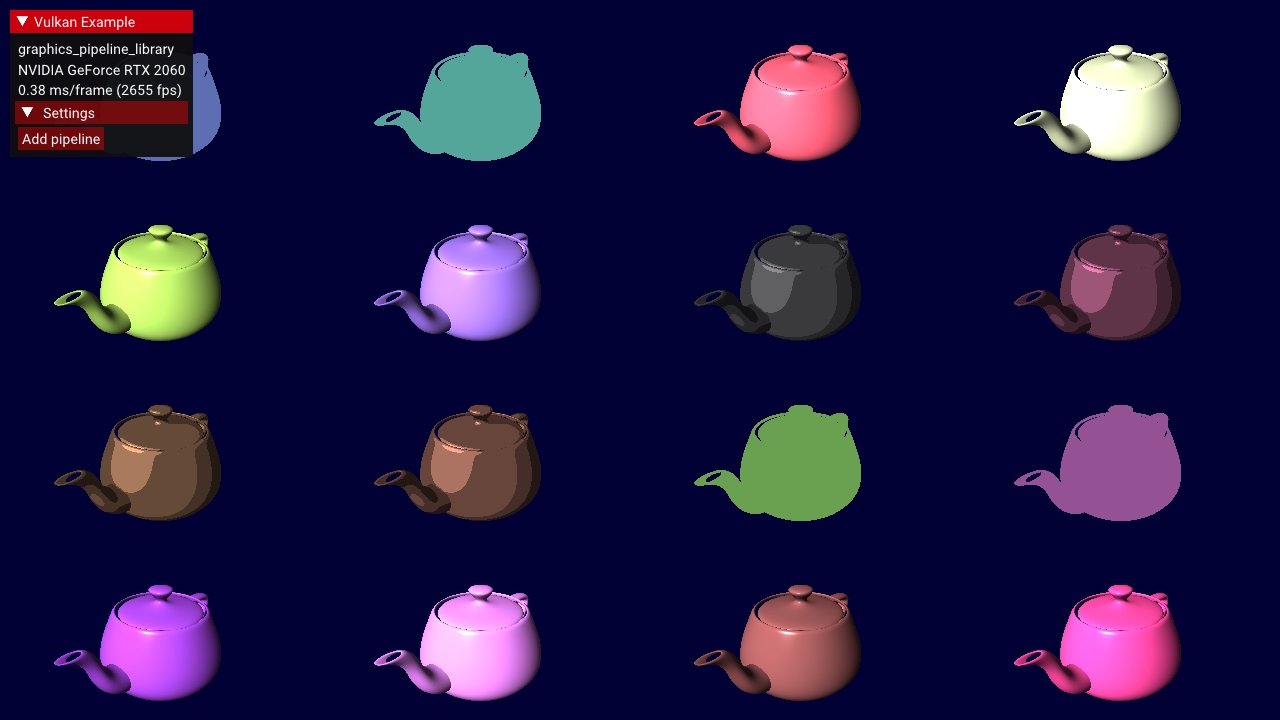Graphics pipeline libraries
| The source for this sample can be found in the Khronos Vulkan samples github repository. |
Overview
The VK_EXT_graphics_pipeline_library extensions allows separate compilation of different parts of the graphics pipeline.
With this it’s now possible to split up the monolithic pipeline creation into different steps and re-use common parts shared across different pipelines.
Compared to monolithic pipeline state, this results in faster pipeline creation times, making this extension a good fit for applications and games that do a lot of pipeline creation at runtime.
Individual pipeline states
As noted above, the monolithic pipeline state has been split into distinct parts that can be compiled independently:
Creating pipeline libraries
Creating a pipeline library (part) is similar to creating a pipeline, with the difference that you only need to specify the properties required for that specific pipeline state (see above). E.g. for the vertex input interface you only specify input assembly and vertex input state, which is all required to define the interfaces to a vertex shader.
VkGraphicsPipelineLibraryCreateInfoEXT library_info{};
library_info.sType = VK_STRUCTURE_TYPE_GRAPHICS_PIPELINE_LIBRARY_CREATE_INFO_EXT;
library_info.flags = VK_GRAPHICS_PIPELINE_LIBRARY_VERTEX_INPUT_INTERFACE_BIT_EXT;
VkPipelineInputAssemblyStateCreateInfo input_assembly_state = vkb::initializers::pipeline_input_assembly_state_create_info(VK_PRIMITIVE_TOPOLOGY_TRIANGLE_LIST, 0, VK_FALSE);
VkPipelineVertexInputStateCreateInfo vertex_input_state = vkb::initializers::pipeline_vertex_input_state_create_info();
std::vector<VkVertexInputBindingDescription> vertex_input_bindings = {
vkb::initializers::vertex_input_binding_description(0, sizeof(Vertex), VK_VERTEX_INPUT_RATE_VERTEX),
};
std::vector<VkVertexInputAttributeDescription> vertex_input_attributes = {
vkb::initializers::vertex_input_attribute_description(0, 0, VK_FORMAT_R32G32B32_SFLOAT, 0),
vkb::initializers::vertex_input_attribute_description(0, 1, VK_FORMAT_R32G32B32_SFLOAT, sizeof(float) * 3),
vkb::initializers::vertex_input_attribute_description(0, 2, VK_FORMAT_R32G32_SFLOAT, sizeof(float) * 6),
};
vertex_input_state.vertexBindingDescriptionCount = static_cast<uint32_t>(vertex_input_bindings.size());
vertex_input_state.pVertexBindingDescriptions = vertex_input_bindings.data();
vertex_input_state.vertexAttributeDescriptionCount = static_cast<uint32_t>(vertex_input_attributes.size());
vertex_input_state.pVertexAttributeDescriptions = vertex_input_attributes.data();
VkGraphicsPipelineCreateInfo pipeline_library_create_info{};
pipeline_library_create_info.sType = VK_STRUCTURE_TYPE_GRAPHICS_PIPELINE_CREATE_INFO;
pipeline_library_create_info.flags = VK_PIPELINE_CREATE_LIBRARY_BIT_KHR | VK_PIPELINE_CREATE_RETAIN_LINK_TIME_OPTIMIZATION_INFO_BIT_EXT;
pipeline_library_create_info.sType = VK_STRUCTURE_TYPE_GRAPHICS_PIPELINE_CREATE_INFO;
pipeline_library_create_info.pNext = &library_info;
pipeline_library_create_info.pInputAssemblyState = &input_assembly_state;
pipeline_library_create_info.pVertexInputState = &vertex_input_state;
vkCreateGraphicsPipelines(get_device().get_handle(), pipeline_cache, 1, &pipeline_library_create_info, nullptr, &pipeline_library.vertex_input_interface);Deprecating shader modules
With this extension, creating shader modules with vkCreateShaderModule has been deprecated and you can instead just pass the shader module create info via pNext into your pipeline shader stage create info.
This change bypasses a useless copy and is recommended:
VkShaderModuleCreateInfo shader_module_create_info{};
shader_module_create_info.sType = VK_STRUCTURE_TYPE_SHADER_MODULE_CREATE_INFO;
shader_module_create_info.codeSize = static_cast<uint32_t>(spirv.size()) * sizeof(uint32_t);
shader_module_create_info.pCode = spirv.data();
VkPipelineShaderStageCreateInfo shader_Stage_create_info{};
shader_Stage_create_info.sType = VK_STRUCTURE_TYPE_PIPELINE_SHADER_STAGE_CREATE_INFO;
// Chain the shader module create info
shader_Stage_create_info.pNext = &shader_module_create_info;
shader_Stage_create_info.stage = VK_SHADER_STAGE_VERTEX_BIT;
shader_Stage_create_info.pName = "main";
VkGraphicsPipelineCreateInfo pipeline_library_create_info{};
pipeline_library_create_info.stageCount = 1;
pipeline_library_create_info.pStages = &shader_Stage_create_info;You can see this in the pre-rasterization and fragment shader library setup parts of the sample.
Linking executables
Once all pipeline (library) parts have been created, the pipeline executable can be linked together from them:
std::vector<VkPipeline> libraries = {
pipeline_library.vertex_input_interface,
pipeline_library.pre_rasterization_shaders,
fragment_shader,
pipeline_library.fragment_output_interface
};
// Link the library parts into a graphics pipeline
VkPipelineLibraryCreateInfoKHR linking_info{};
linking_info.sType = VK_STRUCTURE_TYPE_PIPELINE_LIBRARY_CREATE_INFO_KHR;
linking_info.libraryCount = static_cast<uint32_t>(libraries.size());
linking_info.pLibraries = libraries.data();
VkGraphicsPipelineCreateInfo executable_pipeline_create_info{};
executable_pipeline_create_info.sType = VK_STRUCTURE_TYPE_GRAPHICS_PIPELINE_CREATE_INFO;
executable_pipeline_create_info.pNext = &linking_info;
executable_pipeline_create_info.flags = VK_PIPELINE_CREATE_LINK_TIME_OPTIMIZATION_BIT_EXT;
VkPipeline executable = VK_NULL_HANDLE;
vkCreateGraphicsPipelines(get_device().get_handle(), thread_pipeline_cache, 1, &executable_pipeline_create_info, nullptr, &executable);This will result in the pipeline state object to be used at draw time.
A note on VK_PIPELINE_CREATE_LINK_TIME_OPTIMIZATION_BIT_EXT: This is an optimization flag.
If specified, implementations are allowed to do additional optimization passes.
This may increase build times but can in turn result in lower runtime costs.
The sample

This sample demonstrates that functionality by creating the shared vertex input interface, pre-rasterization shader state and fragment output interface parts only once up-front, and then re-uses them to create pipelines with customized fragment shaders using random lighting models at runtime. Pipelines are created in a background thread and once they’re created, command buffers are updated to display a mesh using the new pipeline.
Independent Descriptor Sets
While this sample doesn’t use it, this extension has a VK_PIPELINE_LAYOUT_CREATE_INDEPENDENT_SETS_BIT_EXT flag that can be used.
Imagine a situation where the vertex and fragment stage accesses two different descriptor sets:
// Vertex Shader
layout(set = 0) UBO_X;
// Fragment Shader
layout(set = 1) UBO_Y;Normally when compiling a pipeline, both stages are together and internally a driver will reserve 2 separate descriptor slots for UBO_X and UBO_Y.
When using graphics pipeline libraries, the driver will see the fragment shader only uses a single descriptor set.
It might internally map it to set 0, but when linking the two libraries, there will be a collision.
The VK_PIPELINE_LAYOUT_CREATE_INDEPENDENT_SETS_BIT_EXT flag ensures the driver will be able to handle this case and not have any collisions.
There are some extra constraints when using this flag, but the Validation Layers will detect them for you.